A Birdwatcher's Guide to Sri Lanka
by Gehan de Silva Wijeyeratne, Lester Perera, Jeevan William, Deepal Warakagoda and Nirma de Silva Wijeyeratne, from OBC Bulletin 26, November 1997.
OBC Bulletin 26 includes a 24 page supplement, the Birdwatcher's Guide to Sri Lanka, which describes 20 key sites. The section for one of those sites, Sinharaja, is presented below. Similar supplements are available for Indonesia, Malaysia and India - see Sales for details.
Itinerary Due to its small size the visitor can comfortably visit virtually all of the good sites in the country in the space of two weeks. The visitor with limited time can judiciously combine the sites for endemic birds with sites of general wildlife interest and also sites with an archaeological or cultural angle. For those travelling in a group the hire of a vehicle is highly recommended as a relatively economical and highly efficient way of visiting the sites. Furthermore entry to the national parks such as Yala or Uda Walawe is by vehicle only and you will need to join a safari if you donít have one.
With the exception of the endangered Sri Lanka Whistling Thrush and the scarce Sri Lanka Bush Warbler all of the endemics have been recorded at Sinharaja. However in the areas visited by birdwatchers some of the montane endemics are unlikely to be seen. Hence to have good coverage of the endemics, as a bare minimum a visit to a wet lowland site such as Sinharaja, Kitulgala or Bodhinagala will need to be combined with a visit to a montane site such as Horton Plains or Hakgala in the mountainous Central Province. For the latter two the hill resort of Nuwara Eliya can be used as a base. Most birdwatchers visit Bodhinagala en route to Sinharaja as it the best place to see the endemic Green-billed Coucal.
Sri Lanka Blue Magpie Bulletin 26 cover (G.M. Henry)
Those who only wish to see the Sri Lankan specialities can skip the low country dry zone sites in the proposed itinerary and proceed to the hill zone from Kitulgala or Ratnapura. However, to see a wider range of Indian sub continent birds and mammals three national parks in the low country Southern Province are very good. Uda Walawe is superb for elephants, but for a greater variety and concentration of mammals visit Yala and/or Bundala.
For the shorebird enthusiast Bundala is a must. Hambantota and Kalametiya are other good sites in the south. On the outskirts of Colombo is the Bellanwila-Attidiya marshes which is superb for water birds.
Visiting the famed lost cities of Ceylon can also be combined with birding. Sigiriya is a spectacular rock fortress not to be missed. The Sigiriya sanctuary is also a well known site for Blue Rock Thrush and the Shahin Falcon, a well distinct race of Peregrine. The archaeological sites at Anuradhapura and Polonnaruwa have plenty of scrub jungle around them that are good for birds.
Of the 468 species and subspecies recorded in the island, the keen birder can expect to see 230 or more (including 20 or so endemics) on a well timed two week visit, when the migrants are in.
Sinharaja Man and Biosphere Reserve SITE: A World Heritage Site since 1988 this is arguably the most important site in Sri Lanka and is internationally important for its bio diversity. The reserve encompasses some of the few remaining sizeable tracts of undisturbed primary lowland rain forest. Much of the birding is however done in areas that were once subject to selective logging.
BIRDS: Sri Lanka Spurfowl, Sri Lanka Junglefowl, Sri Lanka Wood Pigeon, Sri Lanka Hanging Parrot, Sri Lanka Layard's Parakeet, Red-faced Malkoha, Green-billed Coucal, Chestnut-backed Owlet, Sri Lanka Grey Hornbill, Yellow-fronted Barbet, Ceylon Small Barbet, Black-capped Bulbul, Spot-winged Thrush, Scaly Thrush, Brown-capped Babbler, Orange-billed Babbler, Ashy-headed Laughingthrush, Sri Lanka Blue Magpie, White-faced Starling, Ceylon Hill Munia, Sri Lanka Myna, Malabar Trogon, Black Bulbul, Scimitar Babbler, Crested Drongo, Imperial Green Pigeon, Greater Racket-tailed Drongo, Velvet-fronted Nuthatch, Yellow-browed Bulbul.
OTHER FAUNA: Species recorded include mammals (40), butterflies (75), fish (10), Amphibians (10), tetrapods (14), reptiles (29). 50% of the endemic mammals and butterflies are present. Leopard is present but seldom seen. Giant Squirrel and the endemic Purple faced Leaf Monkey can be seen.
TRAILS: Most birders stick to the old logging road between Kudawa base camp and the Research Station, especially during wet periods when the forest trails are full of leeches. For those wishing to trek there is a long trail that runs north-south across the reserve from Kudawa to the town of Deniyaya in the south via the settlement of Watugala. Birders can also try the Waturawa and Moulawella nature trails. The forest trails are good for lizards and leaf litter frogs.
Access: Visitors must register at the Kudawa Forest Department office. The staff will arrange for a compulsory guide to accompany you at the rate of Rs 100 per day. An entry permit is Rs 5.50 for locals and Rs 55 for foreigners.
See Sales for prices and availability of Bulletin past issues Return to Bulletin index

